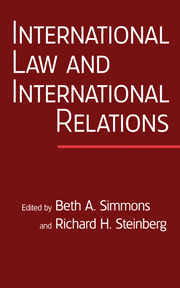Book contents
- Frontmatter
- Contents
- Contributors
- Abstracts
- Preface
- Editors' Note
- PART I INTERNATIONAL REGIMES THEORY: DOES LAW MATTER?
- 1 Structural Causes and Regime Consequences: Regimes as Intervening Variables (1982)
- 2 The Demand for International Regimes (1982)
- PART II COMMITMENT AND COMPLIANCE
- PART III LEGALIZATION AND ITS LIMITS
- PART IV INTERNATIONAL LAW AND INTERNATIONAL NORMS
- PART V TREATY DESIGN AND DYNAMICS
- PART VI LAW AND LEGAL INSTITUTIONS
- PART VII OTHER SUBSTANTIVE AREAS OF INTERNATIONAL LAW
- References
- Index
1 - Structural Causes and Regime Consequences: Regimes as Intervening Variables (1982)
Published online by Cambridge University Press: 05 June 2012
- Frontmatter
- Contents
- Contributors
- Abstracts
- Preface
- Editors' Note
- PART I INTERNATIONAL REGIMES THEORY: DOES LAW MATTER?
- 1 Structural Causes and Regime Consequences: Regimes as Intervening Variables (1982)
- 2 The Demand for International Regimes (1982)
- PART II COMMITMENT AND COMPLIANCE
- PART III LEGALIZATION AND ITS LIMITS
- PART IV INTERNATIONAL LAW AND INTERNATIONAL NORMS
- PART V TREATY DESIGN AND DYNAMICS
- PART VI LAW AND LEGAL INSTITUTIONS
- PART VII OTHER SUBSTANTIVE AREAS OF INTERNATIONAL LAW
- References
- Index
Summary
DEFINING REGIMES AND REGIME CHANGE
Regimes can be defined as sets of implicit or explicit principles, norms, rules, and decision-making procedures around which actors' expectations converge in a given area of international relations. Principles are beliefs of fact, causation, and rectitude. Norms are standards of behavior defined in terms of rights and obligations. Rules are specific prescriptions or proscriptions for action. Decision-making procedures are prevailing practices for making and implementing collective choice.
This usage is consistent with other recent formulations. Keohane and Nye, for instance, define regimes as “sets of governing arrangements” that include “networks of rules, norms, and procedures that regularize behavior and control its effects.” Haas argues that a regime encompasses a mutually coherent set of procedures, rules, and norms. Hedley Bull, using a somewhat different terminology, refers to the importance of rules and institutions in international society where rules refer to “general imperative principles which require or authorize prescribed classes of persons or groups to behave in prescribed ways.” Institutions for Bull help to secure adherence to rules by formulating, communicating, administering, enforcing, interpreting, legitimating, and adapting them.
Regimes must be understood as something more than temporary arrangements that change with every shift in power or interests. Keohane notes that a basic analytic distinction must be made between regimes and agreements. Agreements are ad hoc, often “one-shot,” arrangements.
- Type
- Chapter
- Information
- International Law and International RelationsAn International Organization Reader, pp. 3 - 17Publisher: Cambridge University PressPrint publication year: 2007
- 27
- Cited by



